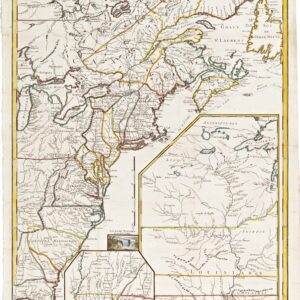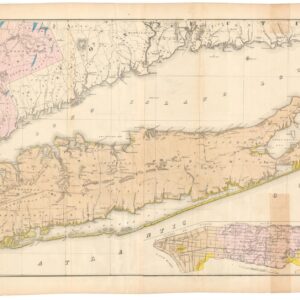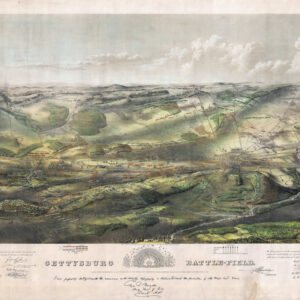A beautiful lithographed map of a well-known Brooklyn landmark.
The Green-Wood Cemetery
$550
In stock
Description
This charming lithograph map of Greenwood Cemetery in the heart of historic Brooklyn was printed in the 1930s by an unknown printer. It was designed to facilitate movement inside the extensive, 478-acre (193 ha) grounds. The map depicts the cemetery’s internal grid system and its many roads and pathways.
Greenwood Cemetery is located in the western part of Brooklyn, bounded by the neighborhoods of South Slope, Park Slope, and Windsor Terrace to the north; Borough Park and Kensington to the south; and Sunset Park and Greenwood Heights to the west. It is part of Brooklyn’s green belt and lies only a few blocks southwest of Prospect Park.
From at least the early 20th century, the cemetery’s boundaries have been defined by some of Brooklyn’s major thoroughfares. The boundary streets have been included on the map to position Greenwood Cemetery within the broader framework of this New York borough. The mapmaker has not oriented the map towards cardinal directions but instead rotates it to provide the visitor with the appropriate overview. At the top of our map, which is essentially southeast, we find the merger of McDonald Avenue and Fort Hamilton Avenue (or Parkway, as it is known today). At the opposite end, which is the bottom of the map, we find Fifth Avenue delineating the cemetery to the northwest and 7th Avenue intersected by it. To the northeast and southwest of the cemetery, and bounding the green along its respective flanks, we find 20th and 37th Street, indicating a spatial width of 17 total blocks.
In 1997, the cemetery joined the National Register of Historic Places, and in 2006 was upgraded to a National Historic Landmark. In addition to the park itself, several of the entrance gates (e.g., 25th Street and Fort Hamilton Parkway Gates), the Weir Greenhouse, and the cemetery’s Chapel have all been designated as important landmarks by the New York City Landmarks Preservation Commission. Greenwood Cemetery has also become the final resting place for many of New York’s notable sons and daughters, including artists like Eastman Johnson, Louis Comfort Tiffany, Leonard Bernstein, and Jean-Michel Basquiat. Characters of historical import and key figures in the creation of modern America (e.g., Thomas Durant and the Fox Sisters) are also buried in its grounds. Our map predates the death of at least some of these people, but it does include a significant number of family gravesites and pathways, hills, artificial lakes, and major buildings such as the chapel or crematorium.
Context is everything
When Greenwood Cemetery was founded in 1838, Brooklyn was still an independent Dutch town known as Breuckelen. With the rapid growth of New York in the 19th century, Breuckelen would soon become an important suburb of New York, but it would only be formally subsumed as a borough in 1898. Thus, when Greenwood Cemetery was founded, the area was still a relatively rural community, but the proximity to a booming New York clearly impacted its popularity. The establishment of Greenwood Cemetery was, in other words, indicative of the rapid urbanization that was taking place within the city itself. Churchyards throughout Manhattan could simply no longer cope with the sheer number of people requiring burial, and so the City Council bought a series of large plots to establish new cemeteries serving New York from its periphery.
21st-century editions of the AIA Guide to New York describe Greenwood Cemetery as “Brooklyn’s first public park by default long before Prospect Park was created.” Certainly, Greenwood Cemetery was laid out and beautified decades before anyone had thought of creating large swathes of green for the ever-growing number of New Yorkers to enjoy their leisure time. Greenwood Cemetery became such a popular destination for weekend outings from the city that it inspired the architectural design competitions for Central Park in Manhattan (in 1857) and, shortly after that, for nearby Prospect Park (announced 1859). Renowned landscape architects Frederick Law Olmsted and Calvert Vaux designed both parks, and were undoubtedly inspired by their own excursions in Greenwood Cemetery.
Cartographer(s):
Condition Description
Scattered soiling and signs of use. Hand watercolor.
References




